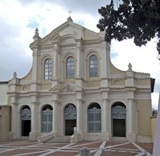
This Franciscan church and convent takes their name from a nearby torrent. In 1390, Ugolino III Trinci gave a fortress on this site to his cousin, the Blessed Paoluccio Trinci. Paoluccio died in the following year, but his successor, Fr. John of Stroncone built a church and convent on the site in 1408-15, which was financed by Ugolino III (died 1415) and by his eldest son, Nicolò Trinci.
The more “observant” members of the community at San Francesco moved here in ca. 1415. They assumed responsibility for the spiritual guidance of the nuns from the following nunneries in Foligno:
-
✴Sant’ Anna, from 1415; and
-
✴Santa Lucia, from 1424.
The complex formally transferred to the Observant congregation in 1450.
The friars at San Francesco and San Bartolomeo retained close ties throughout the 15th century. However, strains began to emerge in 1502, when Cardinal Domenico Grimaldi warned former not to impede the tradition by which friars from San Bartolomeo heard Easter confessions in San Francesco. These tensions must have been exacerbated after the formal split of the Franciscan Order in 1517, albeit that the Observants continued to hear Easter confessions at San Francesco until 1586.
The Amedei Fathers of San Feliciano di Mormonzone joined the friars here in 1576.
The present church was rebuilt in 1731-6.
Interior
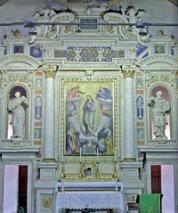
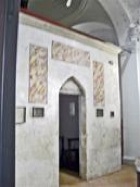
Martyrdom of St Bartholomew (1502-3)
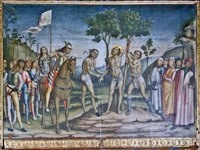
This altarpiece in the Cappella di San Bartolomeo (the 1st chapel to the left) was commissioned from Nicolò di Liberatore, l' Alunno. A codicil to his will in 1502 records that it was "non ancora perfettamente compiuto" (not yet perfectly complete), and obliged Lattanzio di Nicolò to complete it using materials in their workshop. It depicts St Bartholomew tied to two trees while soldiers flay him alive.
Veronica (1558)
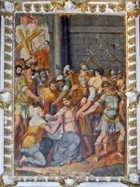
Immaculate Conception (1592)
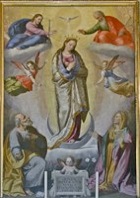
Tota pulchra es, Maria
et macula originalis non est in te
Thou art all fair, O Mary
and the original stain (of sin) is not in thee
SS John of Capestrano and Paschal Baylon (18th century)
This panel on the altar on the right, which is attributed to Tommaso Nasini, depicts two Franciscan saints:
-
✴St John of Capestrano, who had been canonised in 1724; and
-
✴St Paschal Baylon, who had been canonised in 1690.
Art from the Church
Panels of a Triptych (ca. 1415)
Three of the dispersed panels that Federico Zeri (referenced below) attributed to the Maestro della Dormitio di Terni seem to have come from a triptych:
-
✴a panel of the Coronation of the Virgin in the John G. Johnson Collection of the Philadelphia Museum of Art;
-
✴a panel of St Bartholomew in the Pinacoteca Capitolina, Rome (number 353); and
-
✴a panel of St Louis of Toulouse in Heinz Kisters Collection, Kreuzlingen, Switzerland.
Bruno Toscano (referenced below), who doubted the attribution made by Federico Zeri, suggested that the triptych might have come from San Bartolomeo di Marano.
Pietà with saints (early 16th century)
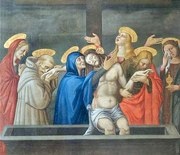
This panel, which now forms part of the Collection of the Fondazione Cassa di Risparmio di Perugia, is attributed to Nicolò di Liberatore, l' Alunno and Lattanzio di Nicolò, and might be the Pietà from San Bartolomeo di Marano that is mentioned in the will of the latter. It depicts the dead Christ on his sarcophagus with the Virgin and SS Francis, John the Evangelist and Mary Magdalen and two other female saints.
Read more:
On the triptych described under “Art from the Church”:
F. Zeri, “Tre Argomenti Umbri”, Bollettino d’ Arte, 18 (1963) pp. 29-45
B. Toscano, “Due Problemi di Storia dell' Arte nel Protomonastero di Sant' Anna”, in
R. Pazzellli and M. Sensi (Eds), “La Beata Angelina da Montegiove e il Movimento del Terzo Ordine Regolare Francescano Femminile”, (1984) Rome
Return to the page on Monuments of Foligno.
Return to Walk III or Around Foligno.



